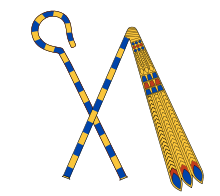Crook and flail
[1] The earliest known example of a crook is from the Gerzeh culture (Naqada II), and comes from tomb U547 in Abydos [citation needed].
[citation needed] The only extant pharaonic examples of both the crook and flail come from the Tomb of Tutankhamun.
[3] Traditionally crossed over the chest when held, they probably represented the ruler as a shepherd whose beneficence is formidably tempered with might.
[5] Percy Newberry, a specialist on ancient Egypt, speculated that the "flail" or "whip/scourge" of Osiris was more likely an instrument for collecting labdanum similar to that used in nineteenth-century Crete.
[6] He examined archaeological remains of such items and their representations in art, and found that they were mechanically incapable of acting as either a flail or whip and so must be some other instrument.

